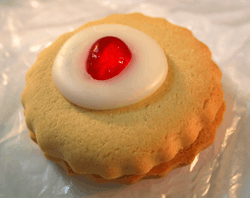Empire biscuit
 | |
| Alternative names | Empire Cookie, Imperial biscuit, double biscuit, German biscuit, Linzer biscuit, Deutsch biscuit, Belgian biscuit, biscuit bun |
|---|---|
| Type | Cake |
| Place of origin | United Kingdom |
| Region or state | Scotland |
| Main ingredients | Biscuits, jam in between two biscuits. The top is covered with white water icing, usually decorated with a glace cherry |
|
| |
An Empire biscuit (Imperial biscuit, Double biscuit, German biscuit, Belgian biscuit, Double Shortbread, Empire Cookie or biscuit bun) is a sweet biscuit popular in the United Kingdom, particularly Scotland, and other Commonwealth countries. It is typically considered a traditional Scottish snack, but is also popular in Northern Ireland.[1]
History
The biscuit was originally known as the "Linzer Biscuit", and later the "Deutsch Biscuit". With the outbreak of World War I it was renamed to Empire biscuit, except in Northern Ireland where it remains known as the German Biscuit or biscuit bun. In Northern Ireland it is commonly found with a jam and coconut topping. It is also known as the "Belgian biscuit", due to being topped in a similar way to a Belgian bun made of pastry or dough.
Ingredients
The typical Empire Biscuit has a layer of jam in between two biscuits, typically Shortbread. The top is covered with white water icing, usually decorated with a glace cherry in the centre, but Jelly Tots are common too. They are derived from the Austrian Linzer Torte.[2] The biscuit is smaller than the Linzer Torte and does not have a cut-out section on the top.
Similar products
Empire biscuits are similar to Viennese Whirls which are a cake.[3]
New Zealand
Known as "Belgium" or "Belgian Biscuit" in New Zealand. Typically found in most bakeries as either a biscuit as described, or in the form of a slice. Typically spiced biscuits are utilised, filled with jam, topped with pink or white icing, and the distinct addition of raspberry jelly crystals scattered on top instead of the cherry.
See also
References
- ↑ http://www.rampantscotland.com/recipes/blrecipe_empire.htm
- ↑ Edmonds Classics Hachette Livre, 2005. pg. 25
- ↑ http://www.tomharris.org.uk/2009/04/25/end-of-empire/ Archived November 26, 2009, at the Wayback Machine.
External links
- Review of biscuit on Nice Cup of Tea and a Sit Down